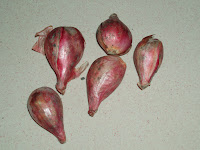The fruit is eaten raw or cooked for its fiery hot flavour which is concentrated along the top of the pod. The stem end of the pod has glands which produce the capsaicin, which then flows down through the pod. The white pith, that surrounds the seeds, contains the highest concentrations of capsaicin. Removing the seeds and inner membranes is thus effective at reducing the heat of a pod.
Chili is often sold worldwide as a
spice in dried and powdered form. In the
United States, it is often made from the Mexican chile ancho variety, but with small amounts of cayenne added for heat. In the
Southwest United States, dried ground chili peppers, cumin, garlic and oregano is often known as
chili powder.
Chipotles are dry, smoked red (ripe) jalapeños.
Chili peppers are also often used around the world to make a wide variety of sauces, known as
hot sauce, chili sauce, or pepper sauce. There are countless recipes.
Indian cooking has multiple uses for chilis, from snacks like
bajji where the chilis are dipped in batter and fried to the infamously hot
vindaloo. Chilis are also dried and roasted and salted for later use as a side dish for rice varieties like vadam (a kind of pappad). In
Turkish or
Ottoman cuisine, chilis are widely used where it is known as Kırmızı Biber (Red Pepper) or Acı Biber (Hot Pepper).
Sambal is dipping sauce made from chili peppers with many other ingredients such as garlic, onion, shallots, salt, vinegar and sugar, which is very popular in Indonesia, Malaysia and Singapore. Chili powder is an important spice in
Persian cuisine and is used moderately in a variety of dishes.
(wikipedia)
Labels: Types





 What is Jengkol? Jengkol is a member of the legume family, closely related to Petai, which grows in length from 1 to 1 and 1/2 feet. Outside it resembles a long string bean, inside is a delicious bean.
What is Jengkol? Jengkol is a member of the legume family, closely related to Petai, which grows in length from 1 to 1 and 1/2 feet. Outside it resembles a long string bean, inside is a delicious bean.


